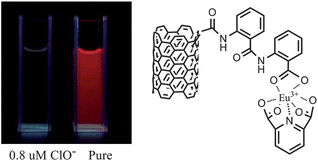A targetable fluorescent sensor for hypochlorite based on a luminescent europium complex loaded carbon nanotube†
Abstract
A new europium complex covalently modified

* Corresponding authors
a
School of Chemistry and Environment, South China Normal University, Guangzhou 510006, P. R. China
E-mail:
qmwang@scnu.edu.cn
Fax: +86-20-39310187
Tel: +86-20-39310258
A new europium complex covalently modified

 Please wait while we load your content...
Something went wrong. Try again?
Please wait while we load your content...
Something went wrong. Try again?
Q. Wang, C. Tan and W. Cai, Analyst, 2012, 137, 1872 DOI: 10.1039/C2AN16247D
To request permission to reproduce material from this article, please go to the Copyright Clearance Center request page.
If you are an author contributing to an RSC publication, you do not need to request permission provided correct acknowledgement is given.
If you are the author of this article, you do not need to request permission to reproduce figures and diagrams provided correct acknowledgement is given. If you want to reproduce the whole article in a third-party publication (excluding your thesis/dissertation for which permission is not required) please go to the Copyright Clearance Center request page.
Read more about how to correctly acknowledge RSC content.
 Fetching data from CrossRef.
Fetching data from CrossRef.
This may take some time to load.
Loading related content
